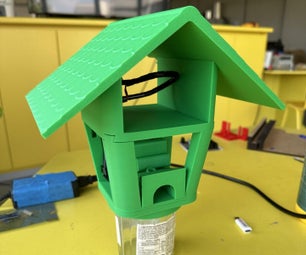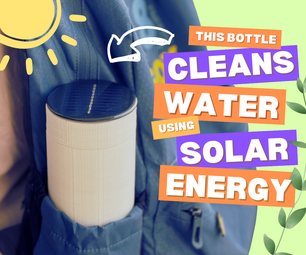Introduction: High-Range Wireless Power
Build a Wireless Power Transmission system that can power a light bulb or charge a phone from up to 2 feet away! This uses a resonant coil system to send magnetic fields from a transmitting coil to a receiving coil.
We used this as a demo during a sermon on Maxwell's Four Great Equations at our church! Check it out at:
Attachments
Step 1: Things You'll Need
- 18 gauge magnetic wire. Note that you can't use regular wire, you have to use magnetic wire (which has a very thin enamel insulation on it). One example is available on Amazon here:
- A 6W (or less) AC/DC 12V Dimmable LED light bulb. One example is here:
- 1uF capacitors (not electrolytics, must be non-polarized). You have some choices here. If you build a low power version, you can get 250V 1uF capacitors from Radio Shack or Frys. If you want to build a high power version, you will need to get special 560V capacitors from Digikey.
- 0.47uF Capacitor (not electrolytics, must be non-polarized)
- Some kind of power amplifier. We used a 450W HI-FI power amp. You could use anything from that down to a PC speaker. The power more you use, the more range you'll get out of it.
- Solder & Solder iron. Wire cutters
- A piece of plywood and some small nails (used for winding coils)
- Black Electrical tape
- Measuring tape & ruler
- Insulated wire
- Hammer
- Audio source with variable frequency and amplitude that generate an 8khz sine tone. It's easy to use a PC, Laptop or phone with freely available tone generation software and connect to the headphone jack. I used a Mac with this software:
https://code.google.com/p/audiotools/downloads/det...
Or you could use this software for a PC:
You could also use a function generator if you have one (expensive piece of test equipment)
NTE Capacitor Part List (for the low power version). You can get these parts at Frys.
3 x 1uF 50V capacitor, NTE CML105M50 (to attach to the light bulb and the small coil)
1 x 0.47uF 50V capacitor, NTE CML474M50 (to attach to the light bulb & small coil in parallel with 1uF caps)
1 x 1uF 250V capacitor, NTE MLR105K250 (to attach to the big coil)
Digikey Order (for the high power version)
Attached is a Digikey Part List that you can use for the higher powered version. These capacitors go up to 560V, which allows you to use a ~500W amplifier, and get up almost two feet of range. The attached version only includes the bare minimum parts. As long as you're making a Digikey order, order some extras in case you make a mistake or blow one up (that's particularly true of the TVS protection diodes, which I smoked several times).
Attachments
Step 2: Make the Coil Winder
In order to wind the coils, you need a frame to wind them around.
On a piece of plywood, you need to use a compass to draw out a precise 20 cm circle and a precise 40 cm circle.
Hammer nails evenly spaced around the circle. For the 20 cm circle, I used around 12 nails and for the 40 cm circle, I used around 16. At one spot in the circle, you'll want to make an entry point that will hold the wire while your beginning the first winding. At that spot, hammer another nail close to one nail, then another a couple inches away.
Step 3: Wind the 40cm Coil With 20 Turns and the 20cm Coil With 15 Turns
You'll first make a few loops with the wire on the outside nail to anchor the wire, then start the loop around the coil. Make sure you leave a lot of extra wire at the beginning and end of the coil. Leave 3 feet to be safe (you'll need this to hook up to electronics).
It's surprisingly hard to keep track of the number of windings. Use a friend to help you.
Make the windings REALLY tight. If you end up with loose windings, the coil will be a mess.
It's really hard to keep the windings in order (especially if you use 18 guage wire, 24 wire gauge is easier to handle but has a lot more loss). So you'll need a few people to help you hold it down as you wind it.
After you finish the turns, you'll want to twist the inlet wire & outlet wire to hold the coil steady. Then tape the coil with electrical tape in several spots.
When you're done with this step you should have two coils, one coil with a 20cm diameter and 15 turns and one coil with a 40cm diameter and 20 turns. The coils should be wound tightly, and secured with tape. You should be able to pick them up and handle them easily without them falling apart or unwinding.
Step 4: Add the Lightbulb & Electronics to the 20cm Coil
Next, you're going to attach the light bulb to the small coil. You need to solder three 1uf (1 microfarad, or said different way 1,000nF) and one 0.47uF (said a different way, 470nF) capacitors to the light bulb posts. That's a total of 3.47uF (capacitors add up in parallel). If you're doing the high power version, you should also solder a 20V bidirectional TVS diode between the light bulb posts as protection against overvoltage.
After you solder the capacitors, you need to twist the ends of the coil wire all the way across the center of the coil. The wire is stiff enough to support the light bulb. After you twist the wire all the way across the diameter, you're going to just cut the ends of the wire and leave them open.
Then you'll place the light bulb in the center of the twisted wire. You'll pull apart the twists, so that each wire touches one terminal of the lightbulb. Then you scrape off the wire enamel with a knife and then solder the cleaned wire to the light bulb posts. Make sure you use rosin core solder. You might want to add extra rosin, which will help clean the bits of enamel.
Step 5: Attach the 40cm Coil to the Electronics.
Next you'll need to connect the 40cm coil to a 1uF capacitor. Shown here is the high power version, where I've connected 10x 0.1uF capacitors in parallel to make one 1uF capacitor (capacitors in parallel add up). The capacitor goes between the coil and the power amplifier positive output. The other side of the coil goes directly to the power amplifier GND.
Step 6: Connect a Sine Wave Source to a Power Amp and Try It Out!
The last step is create a sine wave. You can download a function generator app on your phone or laptop or desktop. You'll want to experiment to find the best frequency of operation.
You connect your sine source to the audio power amp, and then connect the audio poweramp to the 40cm coil and 1uF capacitor, and then everything should work!
If you use a high power audio amp (100W or greater), BE CAREFUL! It can generate very high voltages in excess of +/-500V. I tested with a high voltage scope to ensure I wasn't going to blow up the capacitors. It's also easy to get shocked if you touch an exposed lead.
Also, if you use a high power audio amp, you can't get the 20cm coil too close to the 40cm coil. If they are too close, the TVS diode or LED light bulb will burn up due to excessive power.
Step 7: Create the Wireless Phone Charger
You can easily modify the circuit to charge a phone. I built a second 20cm coil and then added all of the circuitry. The same 3.47uF capacitor and TVS diode is used. That's followed by a bridge rectifier (Comchip P/N: CDBHM240L-HF), followed by a 5V linear regulator (Fairchild LM7805CT), followed by a 47uF tantalum capacitor. With a high power amplifier, the circuit can easily charge your phone from a distance of a foot and a half!
Step 8: The Results
The measured voltage versus distance curves are attached.
Design Measurements, and comparison to simulation & theory
40cm Coil
- Main coil = 0.2m radius, 0.4m diameter. 18 gauge wire 20 windings
- Theoretical resistance = 20.95e-3*(2*pi*0.2*20+0.29*2) = 0.5387 ohms
- Actual resistance = 0.609 ohms. Variance from theory: +13%
- Simulated Inductance = 0.435mH Actual Inductance: 0.49mH. Variance from simulation: +12%
20cm Coil
- Receive coil = 0.1m radius 0.2m diameter 18 guage wire 15 windings
- Theoretical resistance = (2*pi*0.1*15+0.29*2)*0.0209 = 0.2091
Actual Resistance = 0.2490. Variance from simulation: +19%
Simulated Inductance = 0.105mH. Actual Inductance = 0.1186mH. Variance from simulation: +12%
Step 9: Simulation, Optimization & Discussion
How we simulated the design
We simulated and optimized the design in a 2-D mangetostatic simulator, and with SPICE.
We used the free 2-D mangetostatic simulator called Infolytica. You can download for free here:
http://www.infolytica.com/en/products/trial/magnet...
We used the free SPICE simulator called LTSPICE. You can download it here:
http://www.linear.com/designtools/software/
Design files for both simulators are attached.
Discussion
This design uses resonant magnetostatic power transmission. The audio power amp produces an electric current that flows through the transmitting coil and generates an oscillating magnetic field. That magnetic field is received by the receiving coil, and turned into an electric field. In theory, we could do that without any components (i.e. no capacitors). However, the efficiency is extremely low. We initially wanted to make a simpler design that used only the coils and no other components, however, the power efficiency was so poor it couldn't turn on the LED. So we moved to a resonant system. The capacitor that we added resonates at one particularly frequency (in this case about 8kHz). At all other frequencies the circuit is extremely inefficient, but at the exact resonant frequency it becomes very efficient. The inductor and capacitor act like a transformer of sorts. On the transmitting coil, we put in a small voltage and a high current (10Vrms and 15Arms). That ends up producing >400Vrms across the capacitor, but at a much lower current. That's the magic of resonant circuits! Resonant circuits are quantified by the "Q factor". In the 40cm diameter transmitter coil, the measured Q factor is about 40, meaning that's pretty efficient.
We simulated & optimized the coil with Infolytica's 2-D magneto static simulator. That simulator gave us a simulated inductance for each coil, and the mutual inductance between the two coils.
Magnetic Simulated Values:
- Transmitting Coil = 4.35mH
- Receiving Coil = 0.105mH
- Mutual Inductance = 9.87uH. K=6.87e-3 (with the coils separated by 0.2m)
We then took those numbers and fed them into SPICE to simulate the electrical characteristics.
You can download the simulation files attached, and try to make your optimizations and measurements!
Also attached are field plots, that show the magnetic field produced by the coils. It's interesting that even though we're putting in a lot of power, the absolute fields are pretty small (in the milliTesla range). That's because the fields are spread out over a large surface area. So if you add up (integrate) the magnetic field over the large surface area, it would be substantial. But at any given point in the volume it's tiny. As a side note, this is why transformers use iron cores, so that the magnetic field gets concentrated in one area.









